人教版新目标九年级英语Unit3单元说课稿
- 格式:doc
- 大小:39.00 KB
- 文档页数:6

新目标九年级unit3说课稿各位老师上午好!我说课的内容是新目标九年级unit3第一课时,将从教学目标、重难点、教法和教学内容等方面进行课。
一、教材分析本节课以 Could you please tell me where the restrooms are ? 为话题,学习和运用有礼貌的向别人问路展开。
本课教学内容与学生的实际生活密切相关,培养学生运用简单的英语进行询问信息或向别人提供帮助的能力。
从语法上讲要求学生掌握宾语从句的用法。
主要学习内容是:复习以前学习的询问方向方式,学习一种更加有礼貌的问路方式“Do you know where ….?”和“Could you tell me where …?”二、教学目标根据课标要求和本单元的内容,我将本节课教学目标细分为以下几个方面:语言目标、能力目标、情感和态度目标。
1. 语言目标: restroom、stamp 、 bookstore、beside、department、postcard 、bathroom 等Do you know where I can … ?Could you tell me where I can … ?2. 能力目标:能够听懂、会说重要句型及语言结构,并能够有礼貌的准确询问信息。
3. 情感和态度目标:当向他人询问信息时,应注意礼貌用语,养成礼貌的生活习惯;在对话练习中培养学生的合作精神。
三、教学重点及难点教学重点:1. 复习词汇:library, bank, post office等。
2. 复习句型:Where is the post office?以及指路的方法。
如on ,next to ,between …and… ,in front of ,behind ,across from 等。
3. 学习词汇: restroom、get some money, get some magazines, get a dictionary, buy some stamps等4. 学习句型:Do you know where I can … ? Could you tell me where I can …?教学难点:宾语从句的陈述句语序。
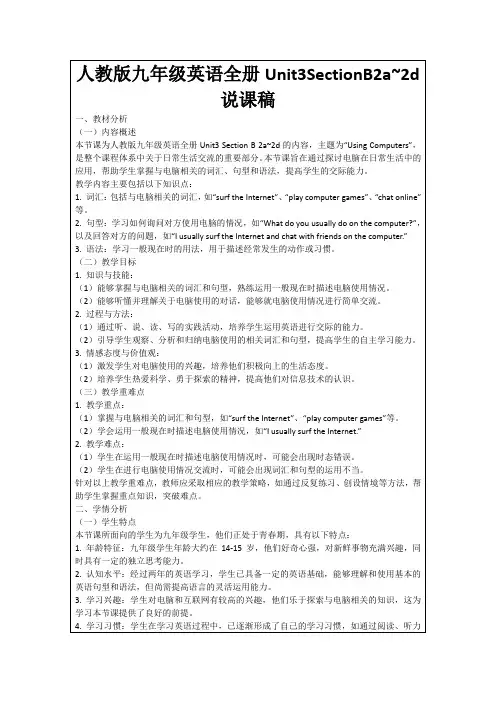

新目标英语九年级Unit 3 Section A说课稿我所说课的内容是九年级英语教材第三单元Section A Page18-19。
一、说教材1.教材简析:本单元所涉及的内容是含有情态动词的被动语态,被动语态是本书当中比较重要的一部分,它把学生由以前所能够进行的主动语态的表达延伸到被动语态的学习和运用。
一方面使学生的语法更趋系统化和完整化,另一方面,它使学生的语言表达更为灵活,更能发展学生的综合语言运用能力。
本课时主要任务是:让学生了解并逐渐理解被动语态,掌握句型结构。
它是由主动语态向被动语态的过渡,更使学生掌握被动语态及其所关联的相关时态的被动语态的结构及运用的关键。
另外本课所涉及的情感教育,于现实十分的有用,它讲述了青少年学生的心理状态,教师可因势利导,更好的接近青少年,解决彼此之间的隔阂和代沟。
激发的培养学生学习英语的兴趣,形成积极的学习态度,促进语言实际运用能力的提高。
2.教学目标新课标明确规定,基础教育阶段英语课程的目标是:以学生语言技能、语言知识、情感态度、学习策略和文化意识的发展为基础,培养学生综合语言运用能力。
依据标准,确定教学目标、重点、难点如下:(1)语言技能目标:学生能听懂课本对话录音,能听懂师生之间就本对话内容而展开的问答,能够针对被允许和不被允许做的事情发表自己的观点,能够叙述同意或不同意的理由,会和别人展开对话,了解和传递信息;能就类似话题,创造性地自编对话;掌握情态动词被动语态的用法。
(2)语言知识目标:学生要牢记所有新学单词,包括重点字母或字母组合的发音,还要记住新学短语、句型;理解和良好运用被动语态。
(3)情感态度目标:通过对学校或其他制度的讨论,培养自己辨别是非的能力对一些社会现象具有判断力和正义感,让学生养成尊重他人,关心他人的好习惯。
(4)学习策略目标:积极主动地投入到语言的实践中去,包括听、说、读、写的实践,学会听取要点,能够运用课本知识联系实际生活。
(5)文化意识目标:了解和反思自己的日常行为是否符合中学生日常行为规范。
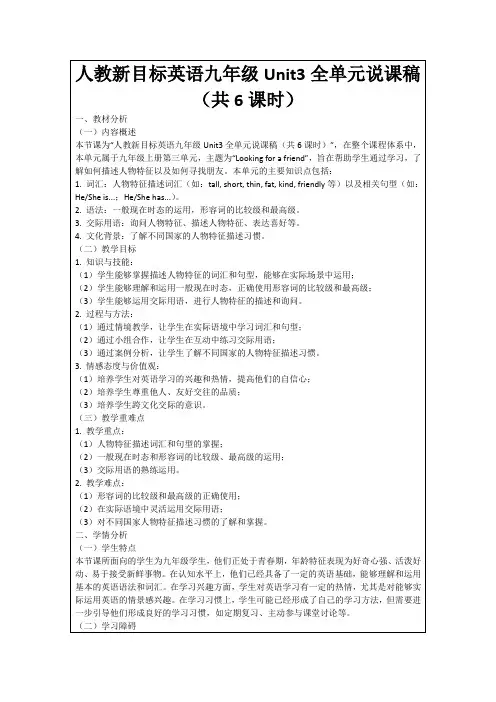
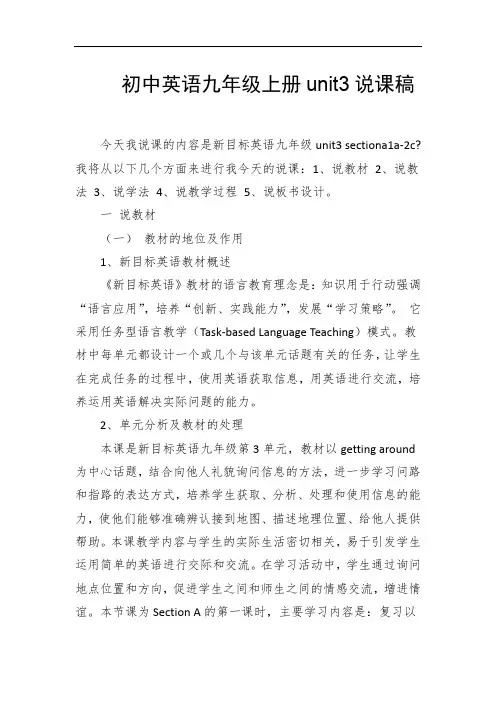
初中英语九年级上册unit3说课稿今天我说课的内容是新目标英语九年级unit3 sectiona1a-2c?我将从以下几个方面来进行我今天的说课:1、说教材2、说教法3、说学法4、说教学过程5、说板书设计。
一说教材(一)教材的地位及作用1、新目标英语教材概述《新目标英语》教材的语言教育理念是:知识用于行动强调“语言应用”,培养“创新、实践能力”,发展“学习策略”。
它采用任务型语言教学(Task-based Language Teaching)模式。
教材中每单元都设计一个或几个与该单元话题有关的任务,让学生在完成任务的过程中,使用英语获取信息,用英语进行交流,培养运用英语解决实际问题的能力。
2、单元分析及教材的处理本课是新目标英语九年级第3单元,教材以getting around 为中心话题,结合向他人礼貌询问信息的方法,进一步学习问路和指路的表达方式,培养学生获取、分析、处理和使用信息的能力,使他们能够准确辨认接到地图、描述地理位置、给他人提供帮助。
本课教学内容与学生的实际生活密切相关,易于引发学生运用简单的英语进行交际和交流。
在学习活动中,学生通过询问地点位置和方向,促进学生之间和师生之间的情感交流,增进情谊。
本节课为Section A的第一课时,主要学习内容是:复习以前学习的询问方向方式,学习一种更加有礼貌的问路方式“Do you know where I can….?”和“Can you tell me where I can…?”(二)说教学目标根据课标及11单元的内容,我将本节课(即section A1a-2c 的第一课时)教学目标细化为以下五方面:语言目标,能力目标,情感和态度目标,策略目标及文化意识目标。
1.语言目标:1)生词和短语restroom,.shampoo, drugstore,cafe, department,2) 重点句子Do you know where I can …?Can you tell me where I can …?2.能力目标:能够听懂重要句型及语言结构,并能够仿照例子学会有礼貌的问路。
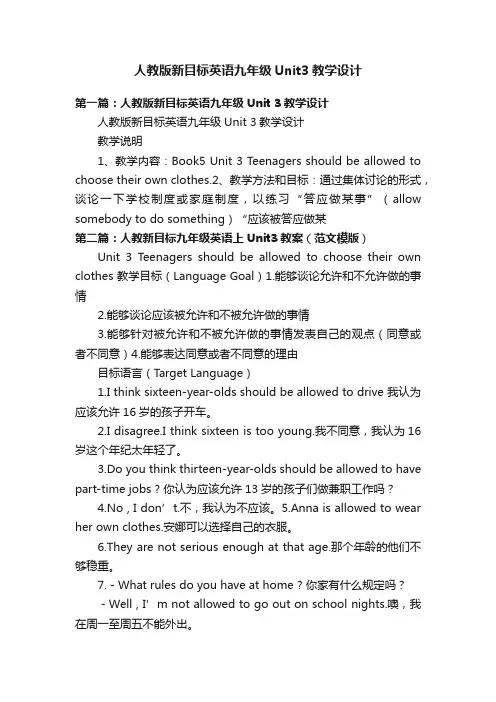
人教版新目标英语九年级Unit3教学设计第一篇:人教版新目标英语九年级Unit 3教学设计人教版新目标英语九年级Unit 3教学设计教学说明1、教学内容:Book5 Unit 3 Teenagers should be allowed to choose their own clothes.2、教学方法和目标:通过集体讨论的形式,谈论一下学校制度或家庭制度,以练习“答应做某事”(allow somebody to do something)“应该被答应做某第二篇:人教新目标九年级英语上Unit3教案(范文模版)Unit 3 Teenagers should be allowed to choose their own clothes 教学目标(Language Goal)1.能够谈论允许和不允许做的事情2.能够谈论应该被允许和不被允许做的事情3.能够针对被允许和不被允许做的事情发表自己的观点(同意或者不同意)4.能够表达同意或者不同意的理由目标语言(Target Language)1.I think sixteen-year-olds should be allowed to drive 我认为应该允许16岁的孩子开车。
2.I disagree.I think sixteen is too young.我不同意,我认为16岁这个年纪太年轻了。
3.Do you think thirteen-year-olds should be allowed to have part-time jobs ? 你认为应该允许13岁的孩子们做兼职工作吗?4.No , I don’t.不,我认为不应该。
5.Anna is allowed to wear her own clothes.安娜可以选择自己的衣服。
6.They are not serious enough at that age.那个年龄的他们不够稳重。
7.-What rules do you have at home ? 你家有什么规定吗?-Well , I’m not allowed to go out on school nights.噢,我在周一至周五不能外出。
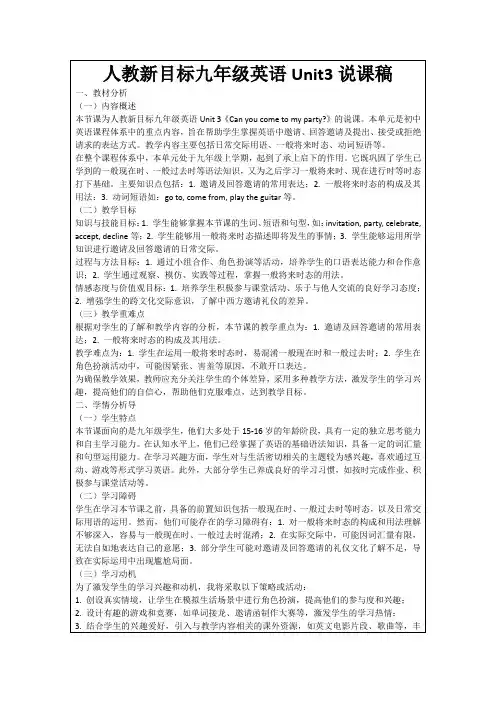
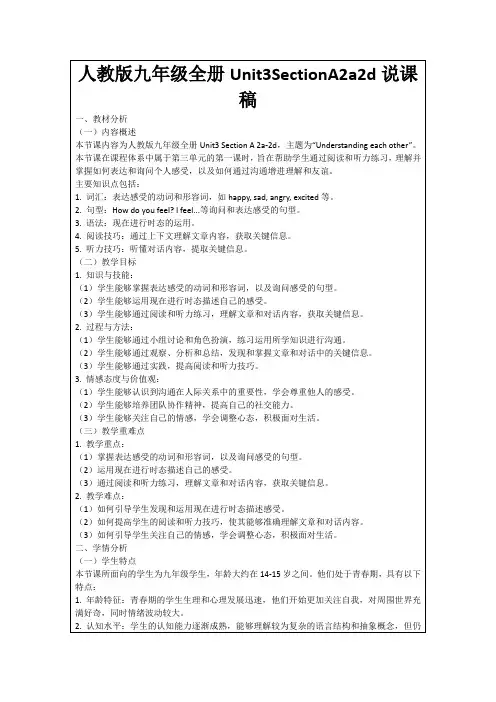

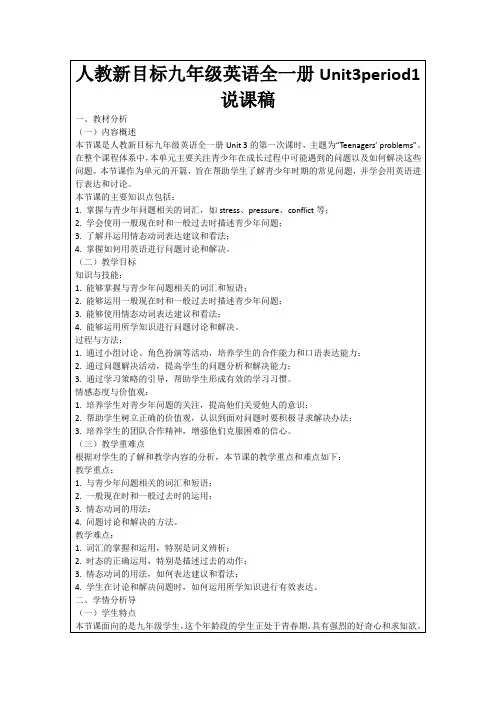

人教版《新目标英语》九年级上册《Unit 3 Teenagers should be allowed to choose their own clothes.》说课稿一、教材分析(一)教材的地位及作用1、新目标英语教材概述《新目标英语》教材的语言教育理念是:知识用于行动,强调语言应用,培养创新、实践能力,发展学习策略。
它采用任务型语言教学(Task-based Language Teaching)模式。
教材中每单元都设计一个或几个与该单元话题有关的任务,让学生在完成任务的过程中,使用英语获取信息,用英语进行交流,培养运用英语解决实际问题的能力。
每一单元由四个版块构成:Section A(基本的语言知识)、Section B(知识的扩展和综合的运用)、Selfcheck(学生自我检测本单元所学的语言知识)、Reading(为了加强学生的阅读能力的大量语篇输入)。
2、单元分析及教材处理本单元以rules为中心话题,让学生学会谈论允许和不允许做的事情;应该被允许和不被允许做的事情;能够针对被允许和不被允许做的事情发表自己的观点,并且能叙述同意或不同意的理由。
本课时的内容为Section A 1a-2c。
:第一模块围绕What should teenagers be allowed to do?这一话题展开思维(1a)、听力(1b)、口语(1c) 训练;第二模块围绕“agrees” and “disagrees”进行听力(2a-2b)、口语(2c) 训练,并就所学语言结构进行总结(Grammar Focus)。
这课时的重点任务是导入新的语言,即New function presenting。
(二)教学目标的确定根据《英语课程标准》关于总目标的具体描述,结合第3单元的教材内容,我按语言目标、认知目标、情感目标三个方面将本课时的教学目标细化:1、语言目标(1)语言结构:含情态动词的被动语态should be allowed to(2)语言功能:谈论规章制度;表达同意或不同意。
Good morning, everyone. I am _______, from _______. I’m glad [ɡlæd] to interpret [ɪn'tɝprɪt] my teaching design here.Today I’m going to talk about Unit 3 Teenagers should be allowed to choose their own clothes.The teaching content [kən'tent] is Section A(1a-2c) of Unit 3 of Go for it , Student’s Book 5 .My teaching design includes Teaching material, Analysis of the Students, Teaching and Learning Method, Teaching Procedure and Blackboard DesignFirstly, let’s focus ['fəʊkəs] on the 1.Teaching materialThe lesson is focused on the topic of rules. Let the students talk about what is allowed to do , express their opinions of these rules and reason. (The content of this unit is closely related to students’ daily life, so it’s easy to encoura ge them to communicate with others. )According to the英语课程标准(Standard of English Curriculum [kə'rɪkjʊləm]), and combination [kɒmbɪ'neɪʃ(ə)n] with this unit ,I divided the teaching aims into three parts:They are Knowledge aims, Ability Aims ,Emotion Aims.The first one is Knowledge Aims:By the end of the lesson, students will be able to read, recognize, and use these words:allow, drive, pierce, driver, license, silly, earring, instead of etc.and this sentence pattern: I think students should be allowed to go out with their friends. (P18)I agree. / I disagree. (P19)The second one is Ability Aims, By the end of the lesson, Ss can make up a similar dialogue. Understand the dialogue better and improve the four kills such as listen, speak, read and write. Besides , Ss can develop their ability of thinking independently.In this lesson, the emotional aim isto encourage the Ss to express their opinions, so they will gain self-confidence.to help them to understand the reasonable advices of parents and teacher.And, the main point of this lesson is :a. New words and phrasesb. Sentence pattern: should be allowed toc. Talking about their opinions of all kinds of rules.The difficult point is:a. The new structure -should be allowed tob. How to develop their communicative ability. Secondly, it is about the students.Our students are in Grade 9 .They are active and curious, interested in new things.After learning English for 2 years, they have some basic English background knowledge, Most students still h aven’t formed good study habit. so the teacher should attach importance to the communication with them, providing them the chances of using language.Now, it talks about teaching and learning methods.In this lesson, I will mainly use “Task-based teaching method”, “Communicative language teaching method” and “TPR teaching method”, and so on.As for the learning method, it is the combination of independent learning and cooperative learningFourthly, let’s focus on the teaching procedures.I will finish the lesson in 5 steps.It will cost about 7 mins.After greeting with the Ss, I will begin the lesson by free talka. Who bought clothes for you?b. Who can buy clothes by herself/himself?And then I will Show the pictures and let the Ss talk about what we can do.The pictures are Go out at night , take mobile phones to school ,do homework with friends,have part-time jobs. In this part, Students will be divided into several groups and do the free talk by them selves.Purpose:The purpose ['pɜːpəs] of this, is to form a better English learning surrounding for the Ss, and, at the same time, it provides situations to review the learnt knowledge such as Go out , do homeworkwith friends, part-time job for the next step.It will cost about 25 mins.With the help of the PPT, I will introduce the new structure -be allowed to. Use “are allowed to ” and “aren’t allowed to ” replace “can do” and “can’t do” .Finish the 1a, Explain the each sentences. Let the Ss express their opinion——agree or disagree. (In this part, we need to help Ss understand these sentences and their grammar.)And then Finish the practices: 1b、2a、2b。
新目标九年级英语Unit3说课稿件-独家精心设计人教版新目标九年级Unit3 Teenagers should be allowed to choose their own cl othes?说课稿一、背景新目标初英语教材采用任务型语言教学(TASK-BASED LANGUAGE TEACHING)模式,融会话题、交际功能和语言结构,形成一套循序渐进的生活话的学习程序。
以学生语言技能、语言知识、情感态度、学习策略和文化意识的发展为基础,培养学生英语综合语言运用能力。
强调从学生的学习兴趣、生活经验和认知水平出发,形成一种师生交往、积极互动、共同发展的过程。
让学生在教师的指导下,通过感知、体验、实践、参与和合作等方式,形成积极的学习态度,促进语言实际运用能力的提高。
二、课题:九年级英语(新目标)Unit3 Teenagers should be all owed to choose their own clothesSection A (1a—2c)三、教材分析1)本课在教材的地位及作用本单元所涉及的内容是含有情态动词的被动语态,被动语态是本书当比较重要的一部分,它把学生由以前所能够进行的主动语态的表达延伸到被动语态的学习和运用。
一方面使学生的语法更趋系统化和完整化,另一方面,它使学生的语言表达更为灵活,更能发展学生的综合语言运用能力。
另外本课所涉及的情感教育,于现实十分的有用,它讲述了青少年学生的心理状态,教师可因势利导,更好的接近青少年,解决彼此之间的隔阂和代沟。
激发的培养学生学习英语的兴趣,形成积极的学习态度,促进语言实际运用能力的提高。
2)教学目标: 1.Master the key words and phrases.2.Learn to t alk about what you are allowed to do or not……?.3.Learn to make use of “主语+have / has +been +过去分词?”3)教学重难点:1.Words and expressions in this unit .2. How to make conversations freely using the target language.3.Master the usage of key sentences structure.4)情感目标: 1.Encourage student to have the courage to express opinions. .2. .To enable students to develop a good habit of respect for others, care for others.5)教学准备:teaching cards , pictures , a tape record er四、教学方法用计算机辅助教学,以任务型教学法为主体,以小组活动,两人协作为依托。
人教版新目标九年级英语《Unit3 Could you please tell me where the restrooms are》教案Section A (1a-2d)1.重点单词:restroom,stamp,bookstore,beside,postcard,pardon,washroom,bathroom,normally,rush2.重点短语:take out the rubbish,fold your clothes,sweep the floor,make your bed,go out for dinner,get a ride3.重点句式:—Could you please tell me how to get to the bookstore?—Just go along Main Street until you pass Center Street.—Do you know when the bookstore closes today?—It closes at 7:00 p.m. today.Do you know where I can get some postcards?I don't mean a room for resting.1.重点短语和句型2.疑问代词、疑问副词引导的宾语从句疑问代词、疑问副词引导的宾语从句一、预习课本P17-18新单词并背诵,完成下面的汉译英。
1.洗手间________ 2.邮票________3.书店________ 4.在旁边________5.明信片________ 6.抱歉________7.洗手间________ 8.浴室________9.通常________ 10.仓促________二、认真预习1a-2d找出下列短语和句型。
1.取一些钱________________________________________________________________________ 2.买一双鞋________________________________________________________________________ 3.—你能告诉我怎么到达商店吗?—沿着Main大街走,直到你经过Center Street。
新目标九年英语英文教案Unit3新目标九年英语英文教案 Unit 3新目标九年英语英文教案Unit 3 Teenagers should be allowed to choose their own clothes. Unit 3 Teenagers should be allowed to choose their own clothes. Part 1: T eaching design (第一部分:教学设计) Structures: should ﹢ be allowed to Target language: I think sixteen-year-olds should be allowed to drive. I disagree. I think sixteen is too young. Do you think thirteen-year-olds should be allowed to have part-time jobs? No, I don’t. Vocabulary: allow, pierce, silly, stay up, drive, driver’s license, Do you think…? I agree. I disagree. I don’t agree. Learning strategies: Reflecting Transforming information Section A Goals ●To learn to use should ﹢be allowed to ●To listen and sp eak about school life Procedures Warming up by learning new words To start with, let’s first go to page 147 to go over the vocabulary for this unit. Read to the tape and try to learn off them by heart. Warming up by learning about “should ﹢be allowed to” We shall first learn to use the structures: “should ﹢be allowed to”. It is actually part of the passive uses of English. Tense Subject Auxiliary Past Participle Singular Plural Present The car/cars is are designed. Present perfect The car/cars has been have been designed. Past The car/cars was were designed. Past perfect The car/cars had been had been designed. Future The car/cars will be will be designed. Future perfect The car/cars will have been will have been designed. Present progressive The car/cars is being are being designed. Past progressive The car/cars was being were being designed. “should ﹢be allowed to” can be used like this: He should be allowed to come. Animals should be allowed to live in the forest. Children should be allowed to watch TV atweekends. 1a Reading and circling For practice of the “should ﹢be allowed to” read the statements in the box on page 18 and circle A for agree or D disagree. 1b Listening and circling Listen and circle “T” for true or “F” for false beside the statement s in the box on page 18. Tapescript Woman:So, what are you doing this afternoon, Anna? Girl:I’m going to the mall with John. He just got his driver’s license. Woman:I’m sorry. You can’t go with John. I don’t think sixteen-year-olds should be allowed to dri ve. They aren’t serious enough at that age. Girl:But I have to go to the mall. Gaby’s getting her ears pierced and I want to watch. Woman:I don’t think sixteen-year-olds should be allowed to get their ears pierced. They might be sorry later. Girl:I agree, but it’s fun to watch. Is it OK if we take the bus? Woman:Well, I guess so. Girl:Great! I want to buy a new blouse at the mall, too. Woman:What kind are you going to buy? Maybe I should go with you. Girl:Aw, Mom. I’m not a child. I think teenagers should be allowed to choose their own clothes. Woman:Well, I just want to be sure you get something nice. Now try to copy the expression_rs from the listening tapescript on the blackboard into your notebook. go to the mall with…, get one’s driver’s license, go with…, allow… to drive, be not serious enough, at that age, get one’s ears pierced, be allowed to get one’s ears pierced, be sorry later, it’s fun to watch, it is OK if…, take the bus, guess so, buy a new blouse at the mall, go with…, should be allowed to cho ose one’s own clothes, get something nice 1c Doing pairwork In pairs look at the statements in activity 1a and make conversation. You may use the phrases in the box on page 18 A: I think teenagers should be allowed to go out with their friends. B: I agree. They are old enough. A: I think teenagers should be allowed to go to the mall with their classmates. A: Ithink teenagers should be allowed to get their driver’s license. A: I think teenagers should be allowed to drive. A: I think teenagers should be allowed to get their ears pierced. A:I think teenagers should be allowed to watch TV at weekends. A: I think teenagers should be allowed to take the school bus. A: I think teenagers should be allowed to buy a new blouse at the mall A: I think teenagers should be allowed to choose their own clothes. B: I agree. They are old/ clever/ strong/ bright/ serious/ kind/ careful/ lucky/ enough. 2a Listening and checking Next we are going to listen and check on page 19 what Kathy thinks. You may circle “Agree”, “Disagree”, or “Doesn’t know” to show what Molly thinks. Tapescript Molly: Larry is working late again tonight, Kathy. Kathy: I know, Molly. I don’t think sixteen-year-olds should be allowed to work at night. Young people need to sleep. Molly: I disagree with you. Teenage boys never get tired. Kathy: Well, maybe. But Larry shouldn’t work every night. Molly: Oh, I agree. He needs time to do homework. Kathy: You know, Molly… he should really cut his hair. Molly: Oh, I disagree. I kind of like it. It looks cool! Kathy: You know what worries me—Larry doesn’t seem to have many friends. Molly: Yeah, I know. I think he shouldn’t work on weekends. Kathy: Oh I agree, Molly. He needs to spend time with friends. Molly: Like you and me? Kathy: Maybe. 2b Listening and numbering You are going to listen again to the recording just now to number Kathy’s and Molly’s reasons in the correct order on page 19. Now you shall copy all the important expression_rs from the listening script. work late, sixteen-year-olds, be allowed to work at night, disagree with…, get tired, work every night, do homework, cut one’s hair, kind of like…, looks cool, have many friends, work on weekends, spend time with … 2c Doing pairwork Next you are going to make inpairs a list of things teenagers should and should not be allowed to do. Discuss your list with your partner. A: Do you think teenagers should be allowed to drive? B: Yes, I think so. A: Do you think teenagers should be allowed to work late at night? B: No, I don’t think so. I don’t think they should be allowed to work late at night. They need to get enough sleep. A: Do you think teenagers should be allowed to disagree with their teachers? B: Yes, I think so. A: Do you think teenagers should be allowed to get tired doing their homework? B: No, I don’t think so. A: Do you think teenagers should be allowed to work every night? B: Yes, I think so. A: Do you think teenagers should be allowed to cut one’s hair? B: Yes, I think so. I kind of like my own style. It looks cool. A: Do you think teenagers should be allowed to have many friends? B: No, I don’t think so. They may meet bad people if they have too many friends. A: Do you think teenagers should be allowed to work on weekends? B: It depends on what they do. They may spend time with parents on weekends. 3a Reading and writing You are to read a dialogue between Sun Fei and Wu Yu on page 20. After reading you shall write in the chart Sun Fei’s and WuYu’s rules. Use “Don’t…” and “You can” to express your ideas. Jot down all the useful phrases form their dial ogue. have a lot of rules, at one’s house, for example, stay at home, on school nights, study at a friend’s house, go to the movies, on Friday nights, to be home by 10:00 pm, on Saturday afternoons, go shopping with…, choose one’s own…, get one’s ears pierced 3b Doing pairwork In pairs role play the conversation in 3a using the information in the chart on page 20. A: What rules do you have at home? B: Well, I’m not allowed to go out on school nights. How about you? A: I’m not allowed to go out on school nights either. But I can watch TV with my sister.A: What rules do you have at school? B: Well, We’re not allowed to go out to movies on school nights. How about you? A: We’re not allowed to go out to movies on school nights either. But We can watch VCD with our teachers on the school playground. 4 Doing groupwork Turn to page 20 and find someone in your group who has to go home after school, who is allowed to stay up until 11:00 pm, who has to stay at home on school nights, who is allowed to watch TV every night, who had to clean up his room every morning.。
人教版《新目标英语》九年级上册
《Unit 3 Teenagers should be allowed to choose their own clothes.》说课稿
一、教材分析
(一)教材的地位及作用
1、新目标英语教材概述
《新目标英语》教材的语言教育理念是:知识用于行动,强调语言应用,培养创新、实践能力,发展学习策略。
它采用任务型语言教学(Task-based Language Teaching)模式。
教材中每单元都设计一个或几个与该单元话题有关的任务,让学生在完成任务的过程中,使用英语获取信息,用英语进行交流,培养运用英语解决实际问题的能力。
每一单元由四个版块构成:Section A(基本的语言知识)、Section B(知识的扩展和综合的运用)、Selfcheck(学生自我检测本单元所学的语言知识)、Reading(为了加强学生的阅读能力的大量语篇输入)。
2、单元分析及教材处理
本单元以rules为中心话题,让学生学会谈论允许和不允许做的事情;应该被允许和不被允许做的事情;能够针对被允许和不被允许做的事情发表自己的观点,并且能叙述同意或不同意的理由。
本课时的内容为Section A 1a-2c。
:第一模块围绕What should teenagers be allowed to do?这一话题展开思维(1a)、听力(1b)、口语(1c) 训练;第二模块围绕“agrees” and “disagrees”进行听力(2a-2b)、口语(2c) 训练,并就所学语言结构进行总结(Grammar Focus)。
这课时的重点任务是导入新的语言,即New function presenting。
(二)教学目标的确定
根据《英语课程标准》关于总目标的具体描述,结合第3单元的教材内容,我按语言目标、认知目标、情感目标三个方面将本课时的教学目标细化:
1、语言目标
(1)语言结构:含情态动词的被动语态should be allowed to
(2)语言功能:谈论规章制度;表达同意或不同意。
(3)知识目标:
词汇:allow, drive, pierce, driver, license, silly, earring, instead of等。
句型:I think students should be allowed to go out with their friends. (P18)
I agree. / I disagree. (P19)
Do you think sixteen-year-olds should be allowed to work at night? (P19) No, I don’t think so.
2、认知目标:掌握关键词汇和目标语言。
3、情感目标:学会谈论自己应该被允许做的事情和不应该被允许做的事情。
学生勇于发表自己的观点和意见,表达同意和不同意;学生明白接受父母、老师的合理化建议,对他们成长的重要性。
(三)教学重点及难点的确定
重点:
1、如何运用should be allowed to 结构表达自己对各种规章制度的看法。
2、表达同意和不同意。
难点:含情态动词的被动语态结构should be allowed to。
二、学情分析:
1、学生学情分析:本班的学生经过两年多的英语学习,有了一定的英语基础知识和听、说、读写的能力;同时,学生们对英语学习有着较浓厚的兴趣。
经过两年的新课程理念的熏陶及实践,有了初步的自主、合作、探究的能力。
2、本单元学情剖析:
主题:谈论规章制度;表达同意或不同意。
学生让辩论一些学校规章制度,例如学生是否应该在学校使用手机、学生是否应该穿校服等。
学生在使用所学目标语言进行辩论时,教师要不断鼓励学生,让学生勇于发表自己的真实观点和想法,增强学生开口讲英语的自信心。
这样既能巩固所学知识,又能提高解决问题的能力以及综合运用语言的能力。
三、教法渗透:
1、教学设计思路:
《新目标英语》中的具体语言目标是通过各种各样的Tasks来实现的;学生需要运用具体而特定的行动来完成一定的交际任务。
因此本节课我将始终引导学生通过完成具体的任务活动来学习语言,让学生为了特定的学习目的去实施特定的语言行动,通过完成特定的交际任务来获得和积累相应的学习经验,让学生在用中学,在学中用(Learning by using, learning for using)。
2、教学方式和手段:
任务型教学法、多媒体辅助教学、情景交际教学法等。
3、学习方法指导:
本节课将在课堂活动中把学生分成两人或四人的学习小组,让他们围绕着课堂任务分工合作,在活动中相互探讨、相互交流、相互合作,从而获得知识、技能和情感体验,发展他们的能力。
四、教学流程:。